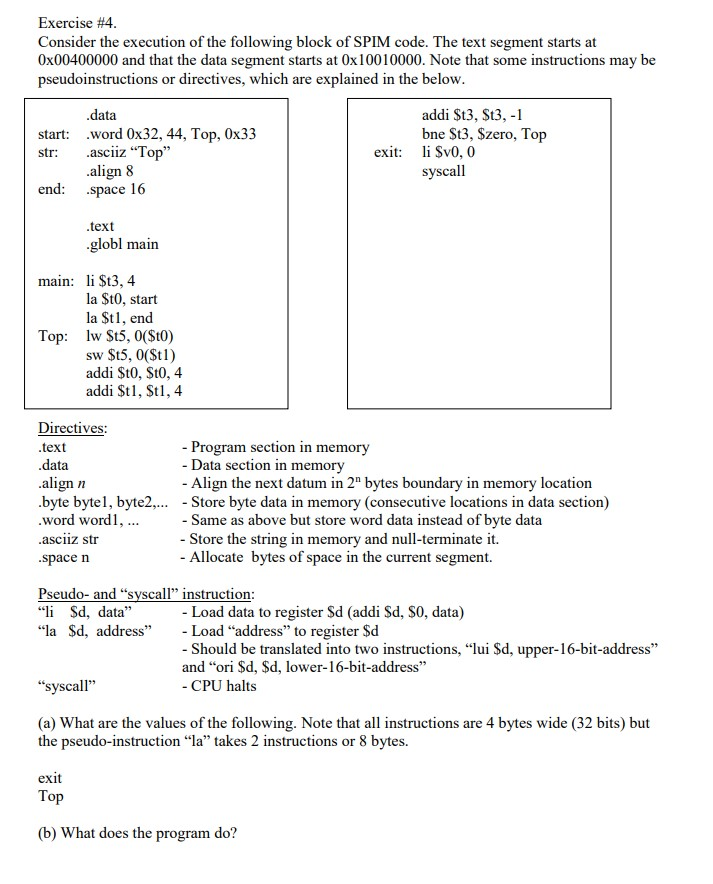
Exercise #4. Consider the execution of the following block of SPIM code. The text segment starts at 0x00400000 and that the data segment starts at Ox 10010000. Note that some instructions may be pseudoinstructions or directives, which are explained in the below. data start: Word Ox32, 44, Top, 0x33 str: asciiz "Top" .align 8 end: .space 16 exit: addi $t3, $t3, -1 bne St3, Szero, Top li $v0,0 syscall .text .globl main main: li $t3, 4 la $t0, start la $t1, end Top: lw $t5, 0($t0) sw $t5, 0($t1) addi $t0,$t0,4 addi $t1,$t1,4 Directives: .text - Program section in memory .data - Data section in memory .alignn - Align the next datum in 2" bytes boundary in memory location .byte bytel, byte2,... - Store byte data in memory (consecutive locations in data section) word word1, ... - Same as above but store word data instead of byte data asciiz str - Store the string in memory and null-terminate it. .space n - Allocate bytes of space in the current segment. Pseudo- and "syscall" instruction: "li Sd, data" - Load data to register $d (addi $d, SO, data) "la $d, address" - Load "address" to register $d - Should be translated into two instructions, "lui $d, upper-16-bit-address" and "ori $d, $d, lower-16-bit-address" "syscall" - CPU halts (a) What are the values of the following. Note that all instructions are 4 bytes wide (32 bits) but the pseudo-instruction "la" takes 2 instructions or 8 bytes. exit Top (b) What does the program do? Exercise #4. Consider the execution of the following block of SPIM code. The text segment starts at 0x00400000 and that the data segment starts at Ox 10010000. Note that some instructions may be pseudoinstructions or directives, which are explained in the below. data start: Word Ox32, 44, Top, 0x33 str: asciiz "Top" .align 8 end: .space 16 exit: addi $t3, $t3, -1 bne St3, Szero, Top li $v0,0 syscall .text .globl main main: li $t3, 4 la $t0, start la $t1, end Top: lw $t5, 0($t0) sw $t5, 0($t1) addi $t0,$t0,4 addi $t1,$t1,4 Directives: .text - Program section in memory .data - Data section in memory .alignn - Align the next datum in 2" bytes boundary in memory location .byte bytel, byte2,... - Store byte data in memory (consecutive locations in data section) word word1, ... - Same as above but store word data instead of byte data asciiz str - Store the string in memory and null-terminate it. .space n - Allocate bytes of space in the current segment. Pseudo- and "syscall" instruction: "li Sd, data" - Load data to register $d (addi $d, SO, data) "la $d, address" - Load "address" to register $d - Should be translated into two instructions, "lui $d, upper-16-bit-address" and "ori $d, $d, lower-16-bit-address" "syscall" - CPU halts (a) What are the values of the following. Note that all instructions are 4 bytes wide (32 bits) but the pseudo-instruction "la" takes 2 instructions or 8 bytes. exit Top (b) What does the program do







